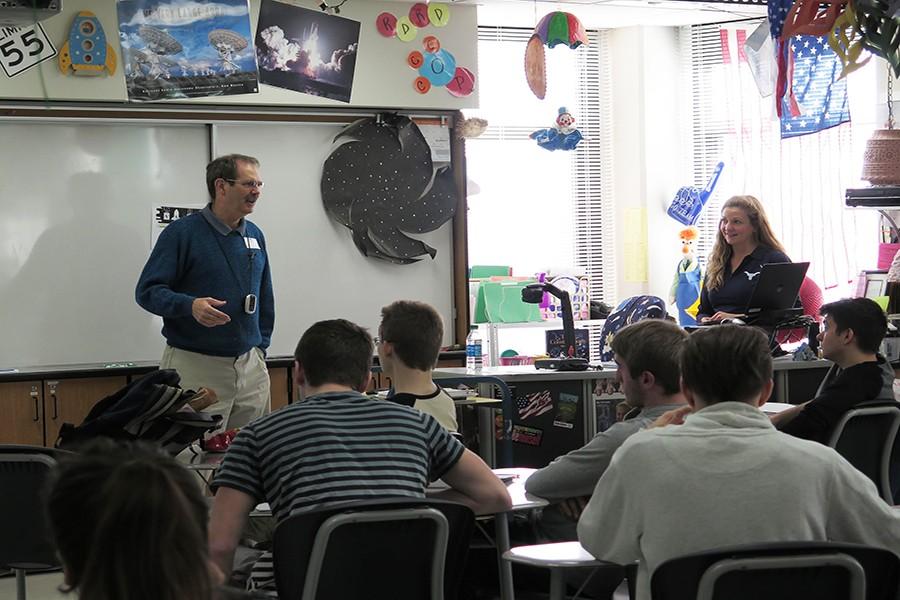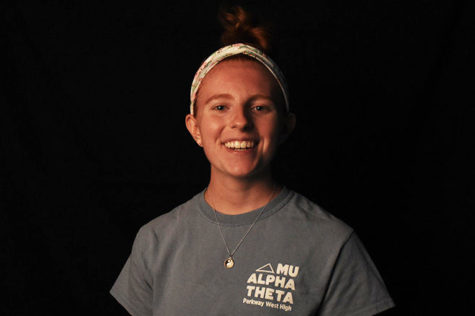On Friday, Mar. 11, a pioneer in the field of helioseismology, the study of the movements of the Sun, Timothy Brown, spoke to Colleen O’Toole’s Astronomy classes. Brown has made numerous contributions to the Kepler telescope.
“There are three kinds of astronomers. The people who do theory, they’re all math and computing all the time. There are people who do observations, they go to the telescopes and use instruments that other people built, and look at stuff in the sky. Then, they go away to their computers and look at data,”Brown said. “There are also instrument builders, and they are the people who make the devices—or, more accurately, they tell the engineers, who really know how to make things, what they want, and work with the engineers to get these things built. I’ve done all of those things in my career, but mostly instrument building,”
Brown pioneered the field of helioseismology by leading a team in the creation of a device called a fourier tachometer and has recently won the James Craig Watson medal for outstanding contributions to the field of astronomy.
“I thought that Mr. Brown was really interesting, he had a lot of information on different telescopes in space, and black holes, and about how they discovered new gravity waves. We’ve been learning in class recently about gravitational waves and black holes, so it fit directly into what we were talking about,” senior Anthony Dyck said.
The class period was split evenly between an autobiographical presentation filled with Brown’s own sense of humor and an open-ended question-and-answer session which lasted until the bell rang.
“Astronomy is a good class, I think it’s one of those things that after you learn it, eventually, you can pull it into your everyday life, and look at the stars and know what’s going on,” senior Lueking Knabe said.
Brown has worked in many branches of astronomy, from helping to discover the composition of the atmospheres of exoplanets, to helping build the Kepler space telescope to physics.
“What I’m really interested in [currently] is young stars, they spin very fast. All stars rotate, but like people, stars start moving pretty fast, and as they get older, they slow down. The Sun goes around once a month. If you look at a young star cluster, say, 100 million or 50 million years old, there are stars that are going around three times per day. So, they slow down by a factor of 100 in a four billion year span… I’m trying to understand the details,” Brown said.
Brown also gave advice to any students looking to pursue a career in astronomy.
“You should learn as much math as you can in high school and more math and physics in college. Don’t specialize in astronomy in college, it’s a waste of your time. Then, when you get to graduate school, you can pick a specialty and get into astronomy and astrophysics,” Brown said. “There will be plenty of time to find out exactly what you want to do. You should try to get into a school with a big department with lots of choices.”




![Smiling in a sea of Longhorns, Fox 2 reporter Ty Hawkins joins junior Darren Young during the morning Oct. 3 pep rally. The last time West was featured in this segment was 2011. “[I hope people see this and think] if you come to [Parkway] West, you will have the time of your life because there are so many fun activities to do that make it feel like you belong here. I was surprised so many people attended, but it was a lot of fun,” Young said.](https://pwestpathfinder.com/wp-content/uploads/2025/10/Edited2-1200x798.jpg)
![West High seniors and families listen as a representative of The Scholarship Foundation of St. Louis, Teresa Steinkamp, leads a Free Application for Federal Student Aid (FAFSA) workshop. This session, held in the library, provided guidance on financial aid, scholarships and student loan options. “This event is very beneficial for any seniors who are applying to or considering applying to colleges after high school [because] the cost of college is on the rise for seniors and parents,” college and career counselor Chris Lorenz said.](https://pwestpathfinder.com/wp-content/uploads/2025/09/DSC_4478-1200x778.jpg)
![Senior Kamori Berry walks across the field during halftime at the Homecoming football game on Sept. 12. During the pep assembly earlier that day, she was pronounced Homecoming Queen. “I thought it was nice that the crowd [started] cheering right away. I know [my friends] were really excited for me, and my family was happy because typically non-white people don't win,” Berry said.](https://pwestpathfinder.com/wp-content/uploads/2025/09/DSC7046-Enhanced-NR-1200x798.jpg)



![Pitching the ball on Apr. 14, senior Henry Wild and his team play against Belleville East. Wild was named scholar athlete of the year by St. Louis Post-Dispatch after maintaining a high cumulative GPA and staying involved with athletics for all of high school. “It’s an amazing honor. I feel very blessed to have the opportunity to represent my school [and] what [it] stands for,” Wild said.](https://pwestpathfinder.com/wp-content/uploads/2025/05/unnamed-6-1200x714.jpg)
![The Glory of Missouri award recipients stand with their certificates after finding out which virtue they were chosen to represent. When discovering their virtues, some recipients were met with contented confirmation, while others, complete surprise. “I was not at all surprised to get Truth. I discussed that with some of the other people who were getting the awards as well, and that came up as something I might get. Being in journalism, [Fellowship of Christian Athletes and] Speech and Debate, there's a culture of really caring about truth as a principle that I've tried to contribute to as well. I was very glad; [Truth] was a great one to get,” senior Will Gonsior said.](https://pwestpathfinder.com/wp-content/uploads/2025/04/Group-Glory-of-Missouri.jpg)

